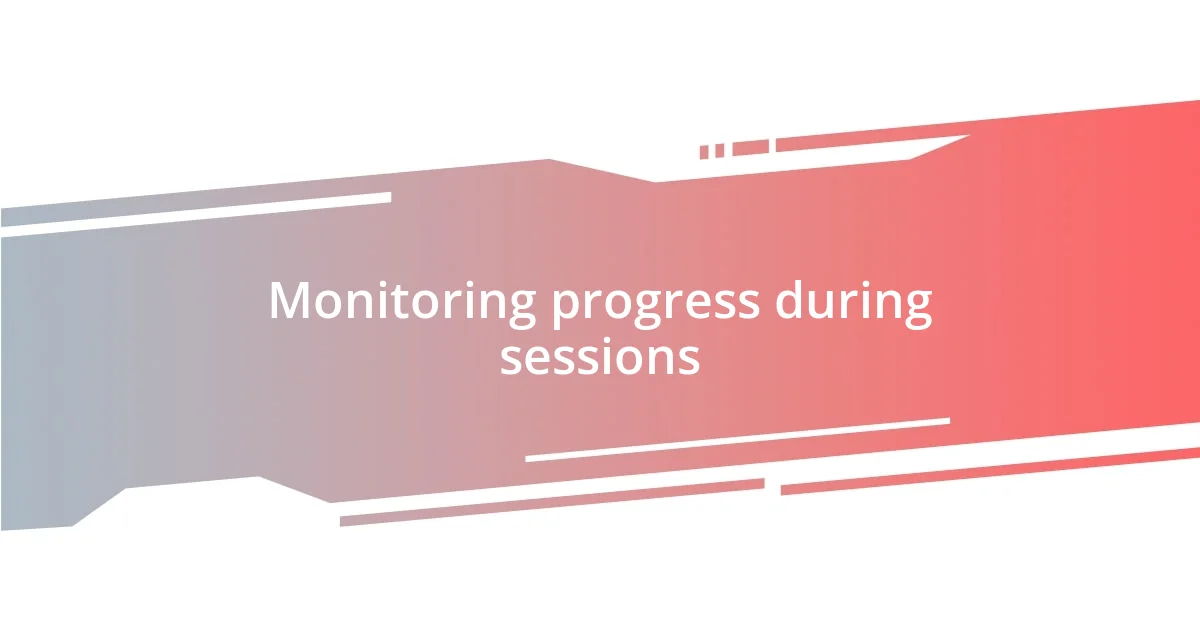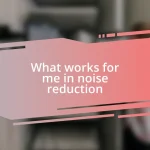Key takeaways:
- Establishing specific session goals boosts focus and motivation, allowing teams to collaborate more effectively and enhance creativity.
- Effective session scheduling, including buffer time and prioritized tasks, improves productivity and prevents fatigue, fostering a better creative environment.
- Continuous monitoring of progress and reflective evaluations after sessions lead to insights that drive improvements and shape future recording endeavors.

Setting clear session goals
When I approach a recording session, I find that it’s crucial to establish specific goals right at the outset. For instance, during one of my recent sessions, I decided that our target was to complete the basic tracks for three songs. This clear aim not only focused our energy but also kept us motivated as we ticked off each song. Have you ever noticed how goals can create a sense of urgency that just propels a session forward?
I’ve learned that breaking down larger projects into manageable objectives can be a game changer. Once, I was overwhelmed by a full album recording, but by segmenting it into song-specific goals, I regained control and clarity. It was incredibly freeing to set a goal like “let’s perfect the guitar solo today” rather than feeling daunted by the entirety of the project. Isn’t it interesting how a single focused intention can transform the overall atmosphere of a session?
Emotionally, I’ve found that setting clear goals not only aligns the team but also fosters a deeper sense of collaboration. During a challenging session, I remember voicing my desire to capture a particular vibe, and suddenly everyone was aligned, bringing their best ideas to the table. It’s in those moments of shared purpose that creativity truly flourishes. How do you feel when you and your team are all working towards a common objective? There’s an energy in that unity that is simply unbeatable.

Planning effective session schedules
Planning session schedules effectively is like laying a solid foundation for a house. I typically begin by assessing the availability of my team and the studio. After one particularly hectic week where I crammed too many sessions into a short timeframe, I vowed never to rush a project again. Now, I find that spreading sessions out over several days allows for much-needed rest and creativity to flourish. Have you ever felt how exhaustion can dampen inspiration?
To further refine our schedule, I incorporate buffer time between sessions. This approach emerged after a marathon recording day during which we ran out of steam. By allowing a short break after each session, I not only rejuvenated the team but also found that the quality of our work improved tremendously. It’s a simple yet effective change that allows creativity to breathe—imagine how that extra time can spark fresh ideas or offer moments of reflection.
I also make it a point to prioritize tasks within our session. I distinctly remember a session where I got too caught up in the details of mixing instead of laying down the initial tracks. Now, I carefully outline what needs to be accomplished and in what order, helping to create a clear and logical flow. This structured approach means that I can approach each session with confidence, knowing we’re tackling the most crucial elements first. Doesn’t having a solid plan give you a sense of empowerment?
| Approach | Description |
|---|---|
| Assess Team Availability | Evaluate when everyone is free to ensure maximum participation. |
| Incorporate Buffer Time | Allow short breaks to rejuvenate the team and enhance creativity. |
| Prioritize Tasks | Outline what to accomplish to maintain a logical flow during the session. |

Preparing your recording environment
Before diving into the actual recording, I pay careful attention to my recording environment. From my experience, the little things can make a big difference, so I always ensure that the space is comfortable and conducive to creativity. For instance, I remember one session where I neglected to adjust the lighting. The harsh overhead lights made everyone feel tense and drained our energy. That’s when I decided to invest in softer lighting. The warm glow instantly shifted the mood, making the space feel more inviting. Have you ever noticed how the right ambiance can inspire creativity?
To set the ideal environment, I focus on several key elements that help me stay productive and inspired:
- Soundproofing: Ensure the room is quiet to avoid unwanted interruptions.
- Comfort: Arrange comfortable seating and temperature control so everyone feels at ease.
- Clutter-Free Space: A clean setup not only looks professional but also helps clear the mind.
- Essential gear: Keep all equipment organized and accessible to minimize distractions.
- Personal touches: Adding a few personal items or artwork can make the space feel more inviting.
By making these small adjustments, I find that both my team and I can channel our best efforts into the music creation process. There’s something incredibly liberating about being in a space that feels just right, don’t you think?

Communicating with session participants
Effective communication with session participants is a game-changer in my recording process. I find that starting with a clear agenda helps everyone understand their roles and expectations. Once, during a particularly chaotic session, I realized that a lack of communication led to confusion and frustration. By having a pre-session briefing, I’ve since noticed that everyone feels more engaged and aligned, reducing the chances of miscommunication.
I also value open dialogue throughout the session. Encouraging feedback allows participants to voice their thoughts and ideas, fostering a collaborative atmosphere. For instance, I remember implementing a check-in after each track. This practice has turned out to be refreshing; it not only gives everyone a moment to reflect but often leads to innovative adjustments that enhance our work. Don’t you think a simple question can spark a wealth of creativity?
Additionally, I believe that checking in on the emotional state of the team is crucial. Sometimes, the pressure of recording can be overwhelming. I’ve learned to tune in and ask how everyone is feeling. When a musician expressed frustration during one session, we paused and took a moment to breathe. That simple acknowledgment shifted the energy, allowing us to return with renewed focus and enthusiasm. Isn’t it remarkable how emotional awareness can elevate a project?

Utilizing technology for efficiency
Utilizing technology in my recording sessions has proven to be a huge time-saver. I rely heavily on software tools such as DAWs (Digital Audio Workstations) to streamline the recording process. Just imagine how much easier it is to edit and arrange multiple tracks with a few clicks rather than manual splicing! This efficiency not only saves time but also allows me to channel my energy into creativity rather than logistics.
Another game-changer for me has been the use of cloud storage for session files. I remember a session where my laptop crashed, and I was panicking about losing hours of work. Thankfully, I had saved everything in the cloud. The relief I felt was tremendous! This experience taught me that having a reliable backup system can prevent potential disasters and keep the creative momentum in flow. Isn’t it reassuring to know that your projects are secured and accessible from anywhere?
Furthermore, I have embraced collaboration tools for remote sessions. With video conferencing software, my team can easily connect, no matter where we are. I’ve had sessions where musicians joined from different states, yet we felt like we were in the same room. Sharing screens to visualize arrangements or even sending files in real time makes a world of difference. Have you ever wondered how many musical ideas can spring to life through a simple video call? The right tech can bridge distances and turn isolation into collaboration.

Monitoring progress during sessions
Monitoring progress during recording sessions is crucial to keep everyone aligned and motivated. I’ve developed a habit of using visual cues, like a progress chart, to show how far we’ve come. I remember one session where we were losing steam; I pulled up the chart, and just seeing our advancements energized the team. It’s remarkable how visualizing progress can rekindle motivation, don’t you think?
I find that setting mini-milestones during a session really helps in gauging where we are. For instance, after completing each section of a song, I take a moment to evaluate our sound and structure. This practice not only keeps us on track but allows us to catch any areas that need tweaking before we move forward. I’ve seen how addressing small issues early can save a ton of time later—what would be more frustrating than realizing you’ve committed to a flawed take?
Additionally, I often ask for a quick round of self-assessments after each major task. I invite everyone to share what they think went well and what could be improved. In one memorable session, a singer suggested a different vocal approach that we had initially overlooked. That’s when I understood the power of collective insight; it’s amazing how allowing everyone a voice can unlock new ideas. Does it surprise you how a brief moment of reflection can lead to such impactful changes?

Evaluating and improving future sessions
Evaluating past recording sessions is a practice I’ve come to cherish. After every project, I set aside time to review the recordings with my team. I vividly recall a particularly tangled session where we struggled with a song arrangement. Listening back, we discovered that simplifying the chorus made such a difference. This process not only highlights our successes but also reveals the areas we can refine. Have you ever listened to your own work and been surprised by what you find?
I also keep a journal where I jot down key takeaways and thoughts after each session. One time, I noted that we spent too long on a particular guitar riff that ultimately didn’t make the final cut. Reflecting on these moments helps me identify patterns that can either propel us forward or hold us back. I believe documenting these insights creates a blueprint for improvement, like having a roadmap for future sessions. Does it resonate with you how past experiences can shape future successes?
To foster continuous improvement, I love involving my team in crafting actionable strategies from our evaluations. During our follow-up meetings, we brainstorm ways to enhance our workflow and communication. I remember a session where a simple chat about our setup led to reorganizing the workspace for better acoustics. Little adjustments can yield big results! How often do you revisit past experiences to fuel your creative journey?















